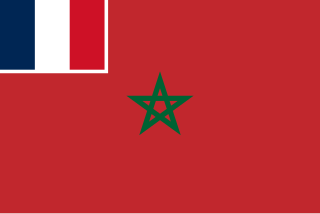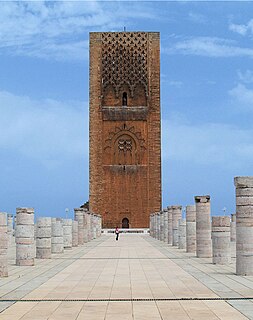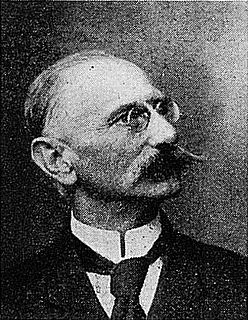Related Research Articles

The French Protectorate in Morocco, also known as French Morocco, was a colonial regime imposed by France in the Sherifian Empire. The protectorate was officially established March 30, 1912, when Sultan Abd al-Hafid signed the Treaty of Fes, though the French military occupation of Morocco had begun with the invasion of Oujda and the bombardment of Casablanca in 1907.
The grands caids were Berber feudal rulers of southern quarter of Morocco under the French Protectorate.

Hassan Tower or Tour Hassan is the minaret of an incomplete mosque in Rabat, Morocco. Commissioned by Abu Yusuf Yaqub al-Mansur, the third Caliph of the Almohad Caliphate in 1195, the tower was intended to be the largest minaret in the world along with the mosque, also intended to be the world's largest. When al-Mansur died in 1199, construction on the mosque stopped. The tower reached 44 m (140 ft), about half of its intended 86 m (260 ft) height. The rest of the mosque was also left incomplete, with only the beginnings of several walls and 348 columns being constructed. The tower, made of red sandstone, along with the remains of the mosque and the modern Mausoleum of Mohammed V, forms an important historical and tourist complex in Rabat.

Khenifra is a city in northern central Morocco, surrounded by the Atlas Mountains and located on the Oum Er-Rbia River. National Highway 8 also goes through the town. The population, as of a 2019 census, was 228,567

The ZaianWar was fought between France and the Zaian confederation of Berber tribes in Morocco between 1914 and 1921 during the French conquest of Morocco. Morocco had become a French protectorate in 1912, and Resident-General Louis-Hubert Lyautey sought to extend French influence eastwards through the Middle Atlas mountains towards French Algeria. This was opposed by the Zaians, led by Mouha ou Hammou Zayani. The war began well for the French, who quickly took the key towns of Taza and Khénifra. Despite the loss of their base at Khénifra, the Zaians inflicted heavy losses on the French, who responded by establishing groupes mobiles, combined arms formations that mixed regular and irregular infantry, cavalry and artillery into a single force.

The French conquest of Morocco began in 1907 and continued until 1934.

The Battle of El Herri was fought between France and the Berber Zaian Confederation on 13 November 1914. It took place at the small settlement of El Herri, near Khénifra in the French protectorate in Morocco. The battle was part of the Zaian War, in which the confederation of tribes sought to oppose continued French expansion into the interior of Morocco. Having captured the strategic town of Khénifra earlier in the year, the French, under General Hubert Lyautey, entered negotiations with Mouha ou Hammou Zayani, who led the Zaian. Lyautey thought that peace could be achieved and ordered Lieutenant-Colonel René Laverdure, who commanded the garrison in Khénifra, not to launch any offensives.

The Battle of Sidi Bou Othman was an important battle fought at Sidi Bou Othman, some 40 kilometers north of Marrakesh, during the French conquest of Morocco. It saw the victory of a French column under Colonel Charles Mangin over the forces of the south Moroccan leader Ahmed al-Hiba in September 1912. As a result of the victory, the French captured the city of Marrakesh and annexed southern Morocco into the French protectorate of Morocco. The conquest was facilitated by the defection of the great qaids of the south, notably the El Glaoui brothers.

Maurice Le Glay was a French Army officer and author of works on Morocco. He served as an artillery and political officer in Algeria, Tunisia and Morocco before retiring to a civil post in 1918 so that he could begin a literary career. He wrote numerous journal articles and several books including a description of the French defeat at the Battle of El Herri. He was a strong admirer of the Berber people, though he was criticised for inspiring the political division of the Berber and Arab peoples in Morocco. He retired to Casablanca, where he died and was honoured with a street named in his memory.
Lieutenant-General Henry Freydenberg was a French army officer. He was born in Paris on 14 December 1876 of German descent family.
General Jean Baptiste Philippe Théveney was a French army officer. His father was a cavalry officer and Théveney was educated at the Ecole Spéciale Militaire de Infanterie before being commissioned as an infantry officer. He served in a number of staff and regimental appointments in France before joining the 1st Foreign Regiment of the French Foreign Legion and seeing active service in Algeria. Théveney followed the regiment to Morocco where it was involved in the Zaian War against the Berbers.
Meski is a small town in Errachidia Province in the Drâa-Tafilalet region of Morocco. It has fewer than 1,000 inhabitants.
General Henri Joseph Simon was a French army officer. He is particularly associated with the French protectorate of Morocco where he spent much of his army career. Simon served as head of intelligence to Hubert Lyautey and as director of the Moroccan Indigenous Affairs Service as well as conventional combat roles. He later wrote books about his time in Morocco and helped the production of the 1934 film Itto.
Colonel Joseph Dérigoin was a French army officer. He served as a lieutenant with the French Foreign Legion in the occupation of Madagascar, distinguishing himself in an attack on a Malagasy fortification. He later rose to command a French column during the Zaian War in Morocco and served as a colonel in the First World War.
Lieutenant-Colonel René Philippe Laverdure was a French army officer. He enlisted in the army as a private soldier in 1880 and saw active service with the 1st Marine Infantry Regiment and the Regiment de Tirailleurs Annamites in the Tonkin Campaign in modern Vietnam. He was promoted through the army's non-commissioned ranks and became an adjutant in 1884. A display of bravery on the battlefield won him a commission later that year.

General Noël Marie Amédée Garnier-Duplessix or Duplessis was a French army officer. Whilst still a colonel he commanded the 2nd Infantry Division in the Allied victory at the First Battle of the Marne before seeing service in the Zaian War in the French protectorate of Morocco. Garnier-Duplessix returned to France in October 1916 and received command of the 37th Infantry Division for the 15 December offensive of the Battle of Verdun and the Nivelle Offensive of April 1917. He received command of the 9th Army Corps in June 1918 and led that unit to victory in the August Battle of Amiens and the autumn Meuse-Argonne Offensive. After the war he was posted to Cilicia in the Franco-Turkish War of 1918–21 where he argued against early withdrawal of troops following the March 1921 Cilicia Peace Treaty.

Colonel Marie Augstin Gaston Cros was a French army officer and archaeologist. He was born in Alsace and was displaced when that territory was incorporated into the German Empire. He joined the French Army as a lieutenant and saw action in Tonkin before spending several years surveying in Tunisia, receiving the honours of membership of Vietnamese and Tunisian orders and appointment as a chevalier of the Legion of Honour. In 1901 Cros was appointed head of the French archaeological expedition to Girsu, Iraq to continue the work of Ernest de Sarzec. His work over the next five years included the tracing of the 32.5 feet (9.9 m) thick city wall and for his work there received a letter of commendation from Gaston Doumergue, the Minister of Fine Arts, and the award of the Golden Palms of the Ordre des Palmes Académiques. Promoted to lieutenant-colonel, Cros served in the French protectorate of Morocco from 1913, seeing action in the Zaian War.
Moha ou Said El Wirrawi was a Moroccan tribal leader who opposed French rule of the protectorate of Morocco. He formerly served as a caïd of the Moroccan sultans and fought for Sultan Abdelaziz against Bou Hmara in 1905. After Treaty of Fes and the start of the French protectorate he opposed the French through military action. He participated in several battles with French forces in the Zaian War but was eventually forced into the High Atlas mountains where he died in action in 1924. His followers continued to resist the French over the next ten years.
General Antoine Jules Joseph Huré was a French army officer and engineer noted for his service in Morocco. Huré joined the army as a volunteer in 1893 and after training at the École Polytechnique and École d'Application de l'Artillerie et du Génie he was commissioned into the 3rd Regiment of Engineers. He spent a number of years with his regiment and on staff appointments in France before transferring to Algeria first with the 19th Army Corps, and then the 15th Army Corps. In 1912 Huré transferred to the general staff in eastern Morocco and earned the Colonial Medal.
Sidi Ali ibn al-Mekki Amhaouch (1844–1918) was a Moroccan religious leader who opposed the French conquest of Morocco. Amhaouch was descended from a long line of marabouts who were influential religious figures in Morocco from 1715. Amhaouch backed two rebellions against the Moroccan government and later fought against the French occupying forces. He declared a defensive jihad against France during the Zaian War but died of natural causes in 1918, three years before the war ended in the tribesmen's defeat. His son, Sidi El Mekki Amhaouch, continued to fight the French until his defeat in 1932. Amhaouch's descendant is a religious leader in modern-day Morocco.
References
- ↑ Hoisington, William A (1995). Lyautey and the French Conquest of Morocco. New York: Macmillan (St Martin's Press). p. 86. ISBN 0-312-12529-1.
- ↑ Jaques, Tony (2007). Dictionary of Battles and Sieges: F-O. Westport, Connecticut: Greenwood Press. p. 383. ISBN 0-313-33537-0.
- ↑ Hoisington, William A (1995). Lyautey and the French Conquest of Morocco. New York: Macmillan (St Martin's Press). p. 85. ISBN 0-312-12529-1.
- ↑ Windrow, Martin (2010). Our Friends Beneath the Sands. London: Phoenix. pp. 449–452. ISBN 978-0-7538-2856-4.
- ↑ Hoisington, William A (1995). Lyautey and the French Conquest of Morocco. New York: Macmillan (St Martin's Press). p. 86. ISBN 0-312-12529-1.
- 1 2 Windrow, Martin (2010). Our Friends Beneath the Sands. London: Phoenix. p. 452. ISBN 978-0-7538-2856-4.
- ↑ Hart, David M. (2001). Qabila: Tribal Profiles and Tribe-State Relations in Morocco and on the Afghanistan-Pakistan Frontier. Amsterdam: Het Spinhuis. p. 104. ISBN 90-5589-204-1.